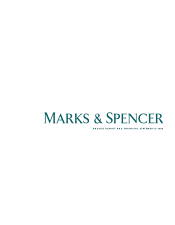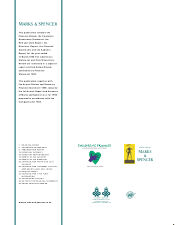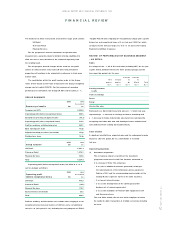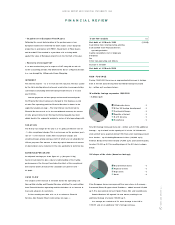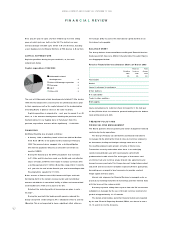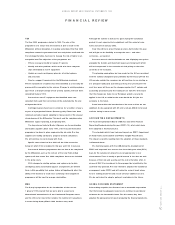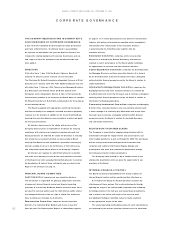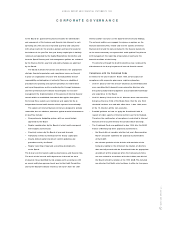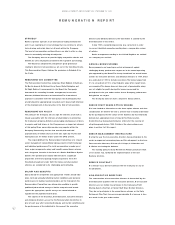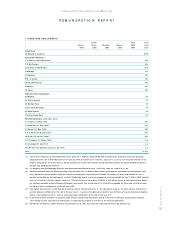Marks and Spencer 1999 Annual Report Download - page 6
Download and view the complete annual report
Please find page 6 of the 1999 Marks and Spencer annual report below. You can navigate through the pages in the report by either clicking on the pages listed below, or by using the keyword search tool below to find specific information within the annual report.
ANNUAL REPORT AND FIN ANCIAL STATEMENTS 1999
FIN AN CIAL REVIEW
N ext year, we plan to open a further 580,000 sq ft of new selling
space of which just over half is in the UK. The bulk of our new
overseas footage (180,000 sq ft) will be in N orth America, including
a new flagship store for Brooks Brothers at Fifth Avenue in N ew York.
CAPITAL EXPENDITURE
Capital expenditure during the year totalled £• m, the main
components being:
The cost of Littlewoods related developments totalled £150m during
1998/99.This included the costs incurred on Littlewoods stores prior
to their opening as well as the capital element of the modernisation
of existing Marks & Spencer stores in the same locations.
Capital expenditure is expected to • next year to around £• m. O f
this, £• m is for overseas development including the purchase of the
freehold interest in our flagship store in Paris.Apart from this
purchase, expenditure overseas will be significantly • 1999/2000.
FINANCING
Additional financing was arranged as follows:
• In January 1999, a subsidiary issued a fixed rate $400m Medium
Term N ote (MTN ) in the public market, maturing in February
2004.The proceeds were swapped into a sterling obligation
with interest payments linked to an attractive rate below six
months £LIBO R.
• During the financial year the MTN programme was increased
to £1.25bn and this has been used as a flexible and cost-effective
source of funds. 25 MTN s were issued in various currencies with
a sterling equivalent of £1,054m. Maturities ranged from 6 months
to 5 years.At the end of the financial year total outstandings within
this programme equated to £1,132m.
O ther sources of finance were US$ Commercial Paper and bank
borrowings both in the London money market and by individual
overseas subsidiaries. A committed facility of $50m and uncommitted
credit facilities of £770m are in place in the UK.
D etails of the maturity profile of borrowings are given in note •
on page • .
D uring the year, both the leading credit agencies reduced the
Group’s long-term credit ratings to AA+ (Standard & Poor’s) and Aa1
(Moody’s).This is not expected to have a significant effect either on
the Group’s ability to access the international capital markets or on
the interest rates payable.
BALANCE SHEET
The Group balance sheet consolidates retailing and Financial Services
businesses which have very different characteristics.The salient figures
are disaggregated below:
Retail & Financial Services Balance Sheets 31 March 2000
Financial Total
Retailing Services Group
1999 1999 1999
£m £m £m
Fixed assets
Stocks
Loans & advances to customers
O ther debtors
N et cash/(debt)
Trade & other creditors
Net assets
Loans and advances to customers have increased to £• bn (last year
£1.9bn).W ithin this, £• bn relates to personal lending with the balance
representing storecard debt.
TREASURY POLICY AND
FINANCIAL RISK MANAGEMENT
The Board approves treasury policies, and senior management directly
controls day-to-day operations.
The Group’s Treasury uses derivatives and financial instruments
to manage risk by altering the interest rates and currency exposures
on investment, funding and foreign exchange contracts so that
the resulting exposures give greater certainty of future costs.
Transactions are only undertaken when there is an underlying
commercial justification and with counterparties which fulfil
predetermined credit criteria.The main types of instrument used
are interest rate and currency swaps, forward rate agreements and
forward currency contracts.The Group does not hedge balance sheet
and profit and loss account translation exposures.W here appropriate,
borrowings are arranged in local currencies to provide a natural
hedge against overseas assets.
Interest rate exposure for Financial Services is managed, as far as
practical, by matching maturities of borrowings and their interest basis
with the terms of the customer debt.
Currency exposure arising from exports from the UK to overseas
subsidiaries is managed by the use of forward currency contracts for
periods of approximately 10 -15 months.
The details of derivatives and other financial instruments required
by the new Financial Reporting Standard, FRS13, are shown in notes
16, 19 and 22-24 to the Accounts.
4
Capital expenditure 1999/2000
■Littlewoods related
developments • %
■O ther UK footage expansion • %
■O verseas • %
■UK IT • %
■O ther UK • %

